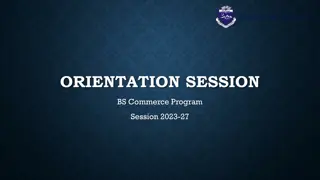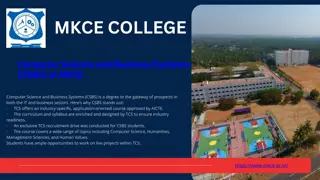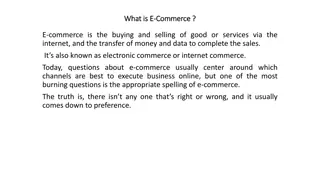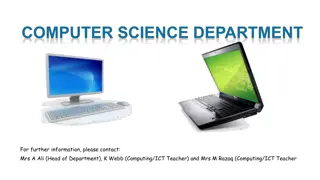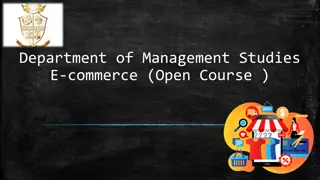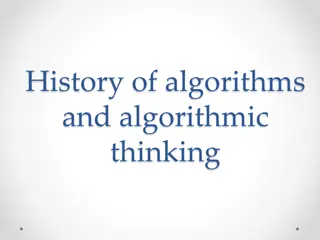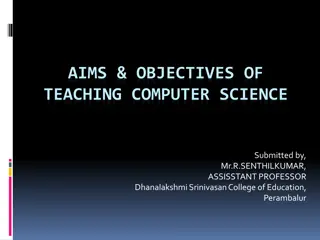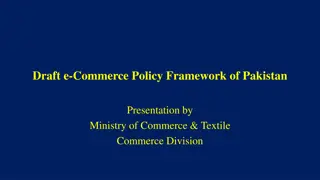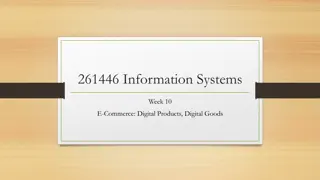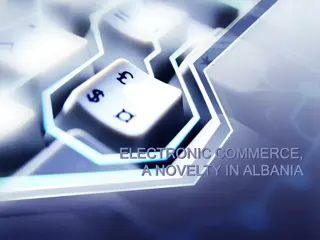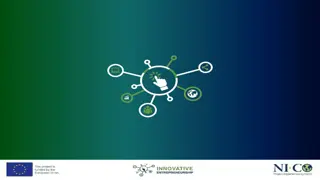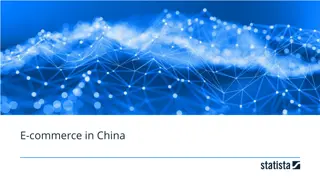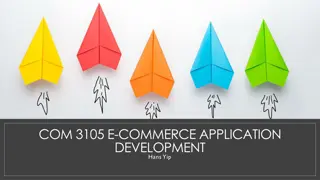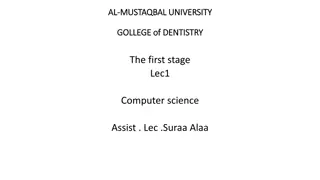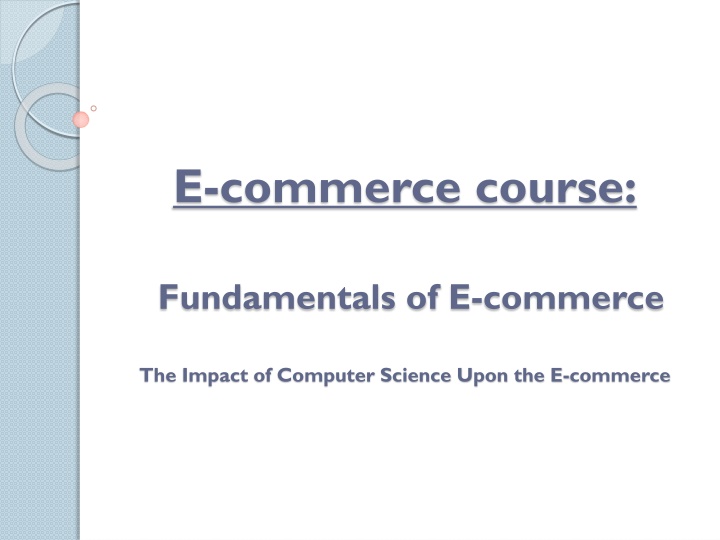
Impact of Computer Science on E-commerce Development
Explore how advancements in computer science have revolutionized the e-commerce industry, shaping the way information is stored, exchanged, and processed online. From the evolution of electronic devices to the role of computer networks and data technology, discover the transformative impact of computer science on e-commerce evolution.
Download Presentation

Please find below an Image/Link to download the presentation.
The content on the website is provided AS IS for your information and personal use only. It may not be sold, licensed, or shared on other websites without obtaining consent from the author. If you encounter any issues during the download, it is possible that the publisher has removed the file from their server.
You are allowed to download the files provided on this website for personal or commercial use, subject to the condition that they are used lawfully. All files are the property of their respective owners.
The content on the website is provided AS IS for your information and personal use only. It may not be sold, licensed, or shared on other websites without obtaining consent from the author.
E N D
Presentation Transcript
E-commerce course: Fundamentals of E-commerce The Impact of Computer Science Upon the E-commerce
The Impact of Computer Science Upon the E-commerce E-commerce is based on electronic information technology, in which information storage, information exchange and information processing are all carried out by computers and Internet. Accordingly, the development of computer science and computer technology have a decisive effect on the development of e-commerce. Since the birth of the first computer with vacuum tubes, electronic devices have gone through the following steps: vacuum-tube circuit, transistor circuit, integrated circuit, large scale integrated circuit (LSI, for short) and very large scale integrated circuit (VLS1, for short).
With the improvement of electronic device manufacturing technology, there emerge minicomputers, large computers and parallel computers. The computer technology, the core of information technology, has gradually become mature after the development of half a century. The computer system is developing to become intelligent, integrated and comprehensive. The birth of multimedia technology enables computers to process various information, such as graphs, texts, voice and images. The success of specialized application software extends the application scope of computers from the single calculation to almost all application fields.
The new technology of computer network and data base a achieve the better share of software, hardware, and information resources within a shorter time, gathering and processing of information cooperatively within an extensive range. The global information revolution has been brought about by a series of breakthrough of digital technologies and the universality of computers and Internet. TCP (Transfer Control Protocol) / IP (Internet Protocol) translates the traditional network into the universal computer network. In addition, emergence and development of new technologies closely related to e-commerce, such as VPN (Virtual Private Protocol), Gigabyte Ethernet wiring system and modem, shape and urge the development of e-commerce.
The computer network has already become principal platform of e- commerce. The universality of TCP / IP greatly facilitates the transmission of information between the networks conveniently, lowers the cost of information acquisition; the emergence of routing technology and the continuous creative innovation of the routing algorithms give full play to network, thus comes the global outburst of Internet. At the same time, the rapid development of the intranet and extranet, based on IP, has turned into the foundation for enterprises to carry out e-commerce. The emergence of WWW technology leads to the boost in Internet users and makes online information more abundant, colorful, multimedialized and easy to accept. The wireless communication is heading for datamation and high bandwidth.
For instance, the GPRS technology can realize the bandwidth of 115 kbps, the 3G mobile communication technology can realize the bandwidth of 2 Mbps and WAP has been widely approved and put into application. Computer network system integrates the technologies of digitization, network and software, and makes telecommunication possible by computer network and computer intelligence node control technologys. It is the telecommunication that enables the rapid development of a series of long-distance applications, such as so called distance education and distance medical treatment etc.
Therefore, the implementation of e-commerce is closely related to the development of computer network, and it is the development of information technology that speedups the development of e-commerce. Computer languages have developed, from machine language, to assembly language, advanced language and even to the intelligence language, and many operating system softwares (e.g. DOS, Windows, UNIX, and Linux), business softwares (Office series, Windows series, LOTUS-1-2-3 series), application softwares (Oracle, Sybase, SQL Server, DB2 data bank system software etc.), specialized application softwares (CAD / CAM, MatLab and financial software) and integrated development softwares (e.g. Power Builder, JBuilder, Delphi).
All the above changes speedup software development, free people from the tiresome mental work of source code compiling to satisfy the basic need to assemble many basic software modules of excellent functions. The data base technology, the key technology of e-commerce, cannot only store all kinds of information (e.g. articles, transactions, and consumers) but also provide market information and decision-making basis by rearranging and analyzing data. The key factor to ensure the popularity of e-commerce is the security of information, for which various encryption technologys such as symmetric key encryption and public key encryption are developed to provide the basis of information privacy. In addition, technologys of firewall and intrusion detection keep information from being destroyed and stolen illegally.
If software design is compared to the construction of modern buildings, in the past it started by mixing pug, baking bricks, picking stones and burning concrete all by manual labors, while presently it is like the construction of a modern building with existing bricks, concrete, and a large number of prefabricated blocks by modern rooters, land scrapers, stirring mills and cranes. Accordingly, much energy can be concentrated on building design and construction management, which enables people to develop e- commerce software at their pleasure is the precondition for the popularity of e-commerce in all industries and work units of all sizes.
Refrences [1] Qin Z., Li S D. An Compendium to E-Commerce. Beijing: Higher Education Press, 2001. [2] Qin Z., Xie G T., Li S D., & Jia X L. E-Commerce System Structure and System Design. Xi an: Xi an Jiaotong University Press, 2001. [3] Qin Z., Han Y. & Yan L X. Computer System Intergration and E-commerce. Xi an: Xi an Jiaotong University Press, 2001. [4] Qin Z., Wang Z M. & Bao F M. Design Practice of Virtual Network. Xi an: Xi an Jiaotong University Press, 2001. [5] Qin Z., Liu X Y. & Wang LR. Case Study on E-commerce. Xi an: Xi an Jiaotong University Press, 2001. [6] Qin Z., Wang Y L., Zhang L. & Wei M T. Virtual Business Management. Xi an: Xi an Jiaotong University Press, 2001. [7] K. Laudon, C. Traver. E-Commerce: Business, Technology, Society (3rd Edition). Prentice-Hall, Inc. NJ, USA. 2006. [8] William G.Page.Jr. A Handbook of Oracle 8/8i Development and Application (the first edition) Beijing: Machinery Industry Press, 2000. [9] Wang Q., Qiu R J. & Wang H W. The Design and Achievement of Client s Information Management System. Information Techniques, Issue 7, 2000, & Issue 87, 2000, 1820. [10] F. Damanpour. E- business E-commerce Evolution: Perspective and Strategy. Managerial Finance. Vol.27 (7): 16-33, 2001. [11] Yu Z T., Song L Z. Che W G. & Guo J Y. The Strategies of Database Techniques in Shopping Vehicles on Internet. Computer Application, No.8, Vol (20), 2000, 6668. [12] W. David. E-commerce: Strategy, Technologies And Applications. TATA MCGRA, India, 2000. [13] Zhang C X., Tang J G. & Xie Y F. The Establishment of Bamboo Product Information System Database and the Design of Information Inquiry Function. Journal of Najing Forestry University Sum No.70, Volume 12, 1996. [14] Daniel I. Joshi, Pavel A. A Complete Collection of References for Java Programmers. (the first edition) Beijing: China Water Conservancy and Hydroelectricity Press, 1999. [15] E. Turban, C. Cohen, I. M. Copi et al. Introduction to E-Commerce. Pearson Education, NJ, USA, 2003. [16] Yen-Liang Chang, Chen, S. Chyun-Chyi Chen Chen, I. Workflow process Definition and Their Applications in E-commerce. Multimedia Software Engineering, 2000. Proceedings. International Symposium on, 2000, 193200. [17] Weaver, A.C. Vetter, R.J. Whinston, A.B. Swigger, K. The future of E-commerce. Computer, Volume: 33 Issue: 10, Oct. 2000, 3031. [18] S. Korper, J. Ellis. The E-commerce Book: Building the E-empire. Morgan Kaufmann, San Fransisco, USA, 2001. [19] Bhaskaran, K. Jen-Yao Chung Das, R. Heath, T. Kumaran, S. Nandi, P. An E-business Integration & Collaboration Platform for b2b E-commerce. Advanced Issues of E-Commerce and Web-Based Information Systems, WECWIS 2001, Third International Workshop on, 2001, 120122. [20] A. Panagariya. E-Commerce, WTO and Developing Countries. World Economy, Vol.23 (8): 959978, 2002. [21] Pi Y. On Technological Crime in the Field of Finance. Legal Science Review, 2000. [22] Qu X W. Crime on Internet and Its Containing. Legal Science Study, 2000. [23] Wang Y. A Brief Analysis on E- commerce Law Issues. Legal Science Review, 2000. [24] Wi J P. E-commerce in China: Problems and Their Countermeasures. China Computer Paper, 1999. [25] Venkatraman, Mahadevan; Singh, Munindar P. Verifying Compliance with Commitment Protocols. Autonomous Agents and Multi-Agent Systems; 13872532; No.3 (2), 1999. [26] Shaw, Michael J. Electronic Commerce: Review of Critical Research Issues. Information Systems Frontiers; 13873326; No.1 (1), 1999. [27] Garrett, S. G. E.; Skevington, P. J. An Introduction to Electronic Commerce. BT Technology Journal; 13583948 No.3 (17), 1999. [28] Unitt, M., Jones, I. C. EDI-The Grand Daddy of Electronic Commerce. BT Technology Journal; 13583948; No.3 (17), 1999. [29] Trask, N. T. Meyerstein, M. V. Smart Cards in Electronic Commerce. BT Technology Journal; 13583948; No.3 (17), 1999. [30] S. S. Y. Shim, V. S. Pendyala, M. Sundaram, J. Z. Gao, Business-to-Business E-Commerce Frameworks. Computer, vol. 33(10): 4047, 2000. [31] D. Kinyon. Quarterly retail e-commerce sales: 4th quarter 2007. US Census Bureau News 2008, CB08-24. [32] A. K. Ghosh, T. M. Swaminatha. Software security and privacy risks in mobile e-commerce. Communications of the ACM, Vol. 44(2): 5157, 2001. [33] S. Hawk. A Comparison of B2C E-Commerce in Developing Countries. Electronic Commerce Research, Vol. 4(3): 181199, 2004. [34] Lu X D. Making and Implementing E-commerce Strategies with Chinese Characteristics. Dongyue Series, 2001(01): 6063. [35] Liu J. Key Points and Measures of E-commerce Strategies in Canana. Global Watch of Science and Technology and Economy, 2000(6): 1415. [36] Tian H. Japan Plans to Be the Most Advanced Country in IT within Five Years. East Web. [37] He D G. Catching up with and Surpassing America: the Dream of Japanese IT Revolution. Army Paper, May 16th, 2002. [38] Japan Publicizes New IT Strategies of the Year 2002. People s Daily, June 28th. 2001. [39] A. Tsalgatidou, J. Veijalainen. Requirements for Mobile E- Commerce in E-Business:Key Issues, Applications, Technology, In: Proceedings of the E-business and E-work Conference, Madrid, Spain, 18-20 October 2000.



